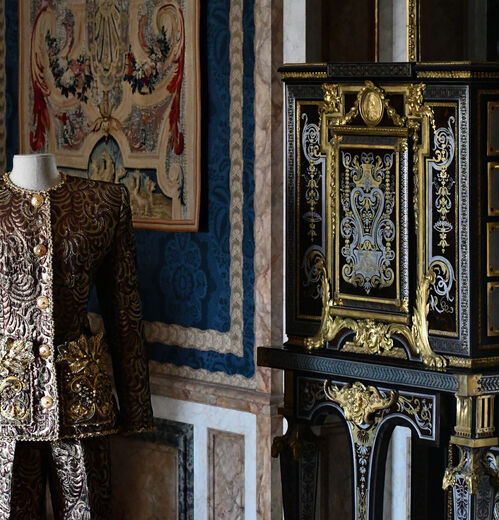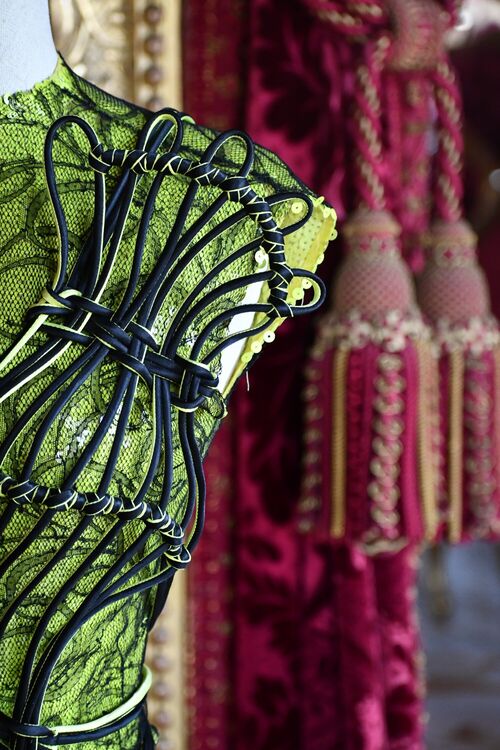The Louvre unveils its first exhibition dedicated to fashion.


For the first time in the Louvre’s 232-year history, the museum is staging an exhibition dedicated entirely to fashion. Titled “Louvre Couture,” the exhibition—which opens today and runs through July 21st—brings together nearly 100 silhouettes and accessories from 45 fashion houses and designers. The show represents a bid to usher the museum into the modern era and invite a younger and broader audience to discover its wonders. For “Louvre Couture,” the museum worked closely with fashion houses and other institutions, such as the foundations for Saint Laurent and Alaïa.
Curated by Olivier Gabet, the museum’s director of the department of decorative arts, with assistance from Marie Brimicombe, the exhibition unfolds across the entirety of the nearly 9,000-square-foot decorative arts wing of the museum. Ensembles, jewelry, purses, and shoes are strategically embedded among the department’s permanent collection of vases, suits of armor, tapestries, furniture, and liturgical instruments from the Middle Ages through to the Renaissance and 20th century.

The impetus for “Louvre Couture” was not to pave the way for a future fashion collection at the Louvre—other institutions across France, including the Musée des Arts Décoratifs, handle that handsomely. Nor was it to stage a definitive history of fashion, which is why there is no Le Smoking from Saint Laurent or Dior’s New Look; though they are key pieces of fashion history, other garments better illustrate the influence of the decorative arts. And it’s not that the museum is in dire need of upping attendance numbers—with 87 million annual visitors, they’ve had to institute a cap at 30,000 daily visitors.
Rather, Gabet wanted to tease out the parallels between object and clothing design, and highlight the profound impact that the symbols, mythologies, forms, and techniques of the decorative arts have had on contemporary fashion. “I was immediately struck by the very obvious, very powerful relationship between a designer and their universe, their collection of books, their perspective on art.…It’s like a sort of walk through someone’s mental universe,” explained Gabet. “And when you examine a designer’s moodboard, the most fascinating pieces are the ones where an image of a period piece of furniture is pasted next to the image of a rockstar.”

Certain designers are widely known to have made deliberate, precise references to historical objects and periods. Gianni Versace’s final presentation for spring/summer 2017 took direct inspiration from the Metropolitan Museum of Art’s “The Glory of Byzantinum” exhibition, which he attended shortly before sending an evening gown made of gold metal mesh, adorned with crosses, down the runway. In the show at the Louvre, this dress is presented alongside an 11th-century reliquary of the True Cross. Or take Balenciaga’s Demna, who draws inspiration from the intersection of technology and humanity. His fall/winter 2023–24 haute couture armor-style gown is strikingly installed at the Louvre catty-corner to a suit of armor once belonging to King Henry II.
But perhaps the best example is the late Karl Lagerfeld of Chanel, Chloé, and Fendi, whose obsession with 18th-century French design reached another level. He knew the holdings of the Louvre’s decorative arts department by heart and pulled direct embroidery references for his last Chanel couture collection from a blue and white commode in the museum’s collection.
The standout of the show is the ornate Napoleon III living quarters, where evening gowns from Jean Paul Gaultier, Giambattista Valli, and John Galliano are staged across grandiose 19th-century apartments. In these domestic settings, the pieces take on a different aura than their counterparts displayed elsewhere in the wing. In the dining room, an ensemble from Demna stands watch over the 50-seat dining table, as if right at home.
Source: View source





